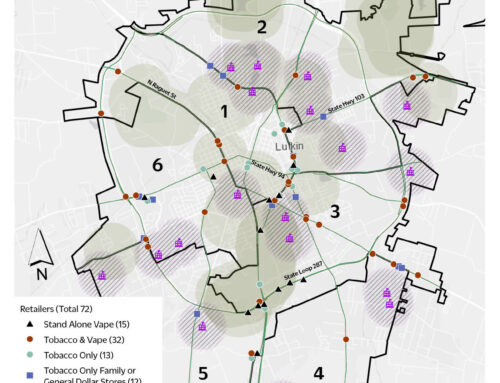Many neighborhoods lack access to traditional supermarkets and other sources of fresh, healthy food, especially at an affordable price. Making healthy choices easier in the retail environment has the potential to make a significant impact on the health of communities. Here are a few recommended strategies to create healthier small food stores.
Just how the tobacco retail environment plays a role in smoking behaviors, the food retail environment is an important driver for dietary choices. Unlike the abundance of tobacco retailers available in low-income neighborhoods, many of these same neighborhoods lack access to traditional supermarkets and other sources of fresh, healthy food, especially at an affordable price. Many healthy retail initiatives often focus on encouraging small stores to offer high quality and affordable healthy foods and beverages. Generally, these strategies can be implemented more quickly and at a lower cost than developing new supermarkets in areas with limited healthy food access. Public health practitioners at the local level can play a valuable role in improving access, availability, and affordability of healthier foods and beverages.
Here are a few strategies recommended by the CDC to create healthier small food stores:
Support physical improvements for access to healthier foods
In order to increase the capacity of small stores to sell healthy foods, interior improvements are often necessary. These improvements include items such as display shelving, refrigeration, and freezers. In addition, exterior improvements, such as signage, painting, lighting, and graffiti or litter removal, can also help to improve community perception of a store and raise awareness about interior changes. If retailers are new to stocking fresh foods like produce, they may benefit from training and technical assistance on food safety recommendations.
Assist with promotion and marketing of healthier foods
Every year, food and beverage manufacturers dedicate billions of dollars to in-store marketing efforts, such as prominent placement, discount pricing, and other promotion efforts. In many cases, this in-store marketing is focused on unhealthy products, especially in low-income communities and communities of color. However, these same types of marketing strategies can be used to promote healthier foods. Some of these interventions may include adding shelf labeling or other point-of-purchase prompts to guide customers to healthier choices, advertising healthier foods, having lower price points for healthier items, or placing healthier options at eye level or in check out areas or other prominent places. Cooking demonstrations and taste tests are other examples of in-store marketing opportunities that may be valuable to the community. Additional research is needed to fully understand the most effective marketing strategies for increasing healthy food purchases.
Encourage small stores to accept nutrition assistance program benefits
Ensuring small food stores accept nutrition assistance benefits of programs like the Special Supplemental Nutrition Program for Women, Infants, and Children (WIC) and the Supplemental Nutrition Assistance Program (SNAP) is an important part of making sure healthy food is affordable for low-income shoppers. To become an approved vendor for WIC or SNAP, stores are generally required to meet specific stocking requirements of healthy foods which is sometimes challenging for small retailers. Public health practitioners can play an important role in raising community awareness about the retailers that accept federal nutrition assistance programs and the availability of healthy food options.
Offer guidance to improve distribution systems for healthy food
For small store owners, procurement is often a major barrier to stocking healthy foods. In many cases, wholesales only offer produce in quantities that are too large for stores to sell before the product spoils. Delivery fees and minimum purchase requirements can also make this option cost-prohibitive for small food retailers. There are a wide range of innovative strategies public health professionals have used to assist store owners with procurement. Some of these ideas include connecting local food suppliers directly to retailers, creating small store buying groups, and establishing partnerships with larger grocery stores or institutions. Another key part of decreasing financial risk for store owners is ensuring there is community demand for new product offerings, which is why strategies like community outreach, and in-store promotion and marketing are so important.
Making healthy choices easier in the retail environment has the potential to make a significant impact on the health of communities. This impact can even be amplified by taking a comprehensive approach to healthy retail initiatives, including strategies that incorporate tobacco use prevention, nutrition and alcohol prevention partners.
Counter Tools can help support public health practitioners in planning healthy retail initiatives. Send us an email at [email protected] to learn more!
Photo by Mehrad Vosoughi on Unsplash





